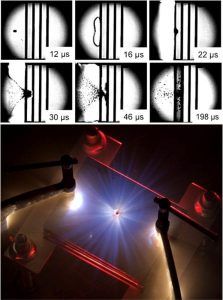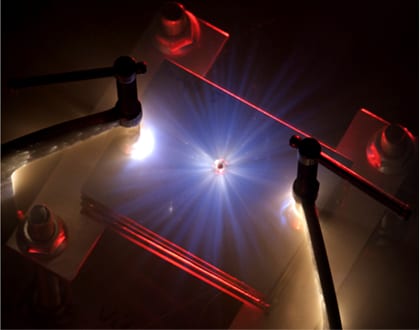
Hypervelocity impact of an aluminum sphere into a 4 layer Whipple-type shield of bulk metallic glass panels.
Trapped orbital debris in low-earth-orbit (LEO) is an increasing threat to spacecraft and satellites. While eliminating this threat is virtually impossible, spacecraft shields can be developed that mitigate the impact of small projectiles, protecting vital electronics and hull integrity. Designing new materials and shield configurations that are more robust to these hypervelocity impacts is a major challenge, owing to the balance between ballistic performance and density that is required for practical shields.
Bulk metallic glasses (BMGs) and their derivative composites appear to be optimal materials with which to fabricate spacecraft shields due to their combination of high hardness, low melting temperatures, relatively low density (similar to titanium), their formability, and their high toughness. BMGs can be used in a variety of configurations for shields, from cellular structures to composite panels.
In new research in this area, a Californian research group subject BMGs and composite shields to high velocity impacts in an attempt to characterize the ballistic limit of these novel materials. BMGs are shown to have poor spalling behavior, which can be mitigated through the use of toughened composites. The team have previously shown that BMG composites have excellent ballistic performance when fabricated into cellular structures and the current work extends those results to toughened panels.

















